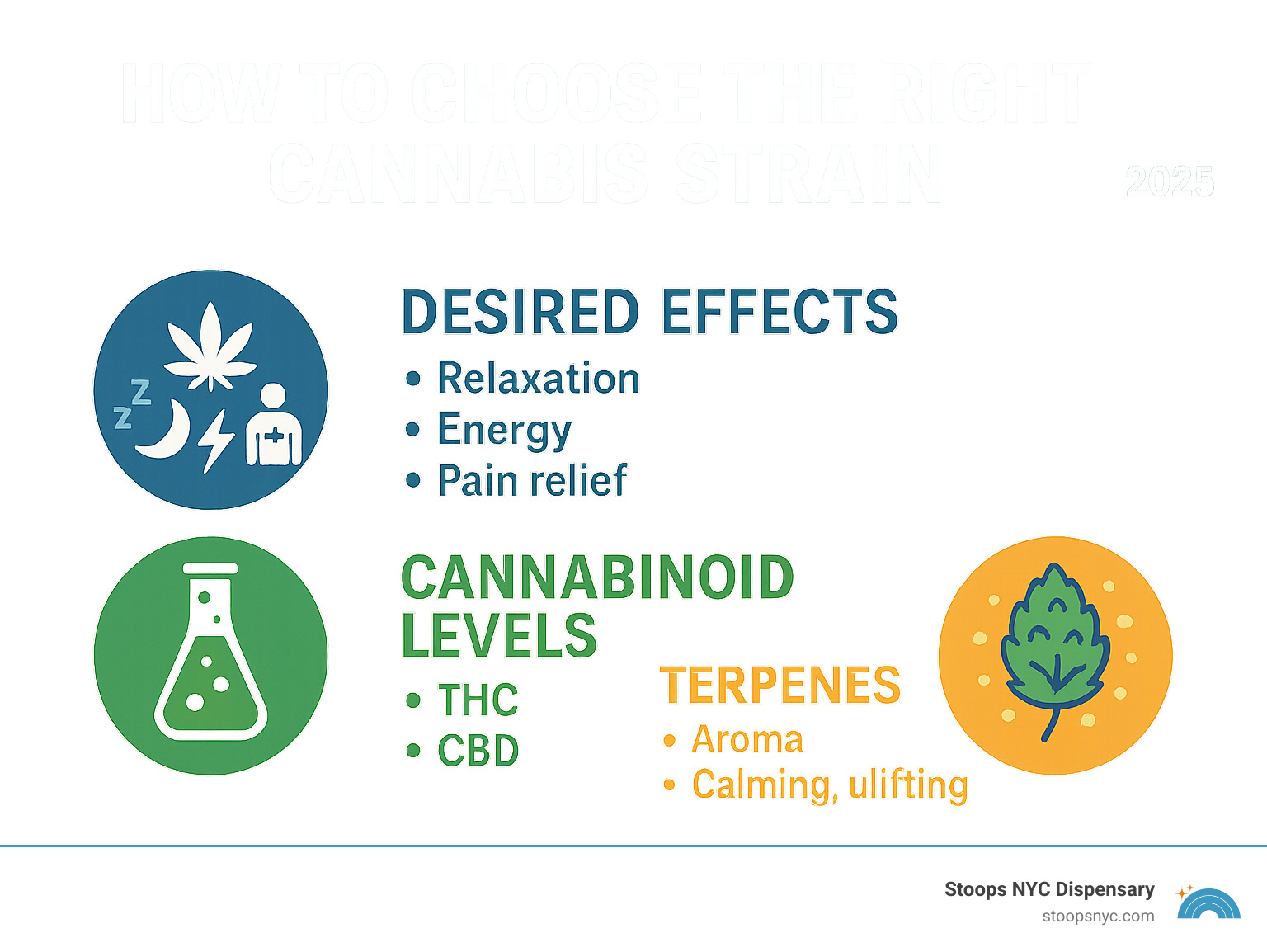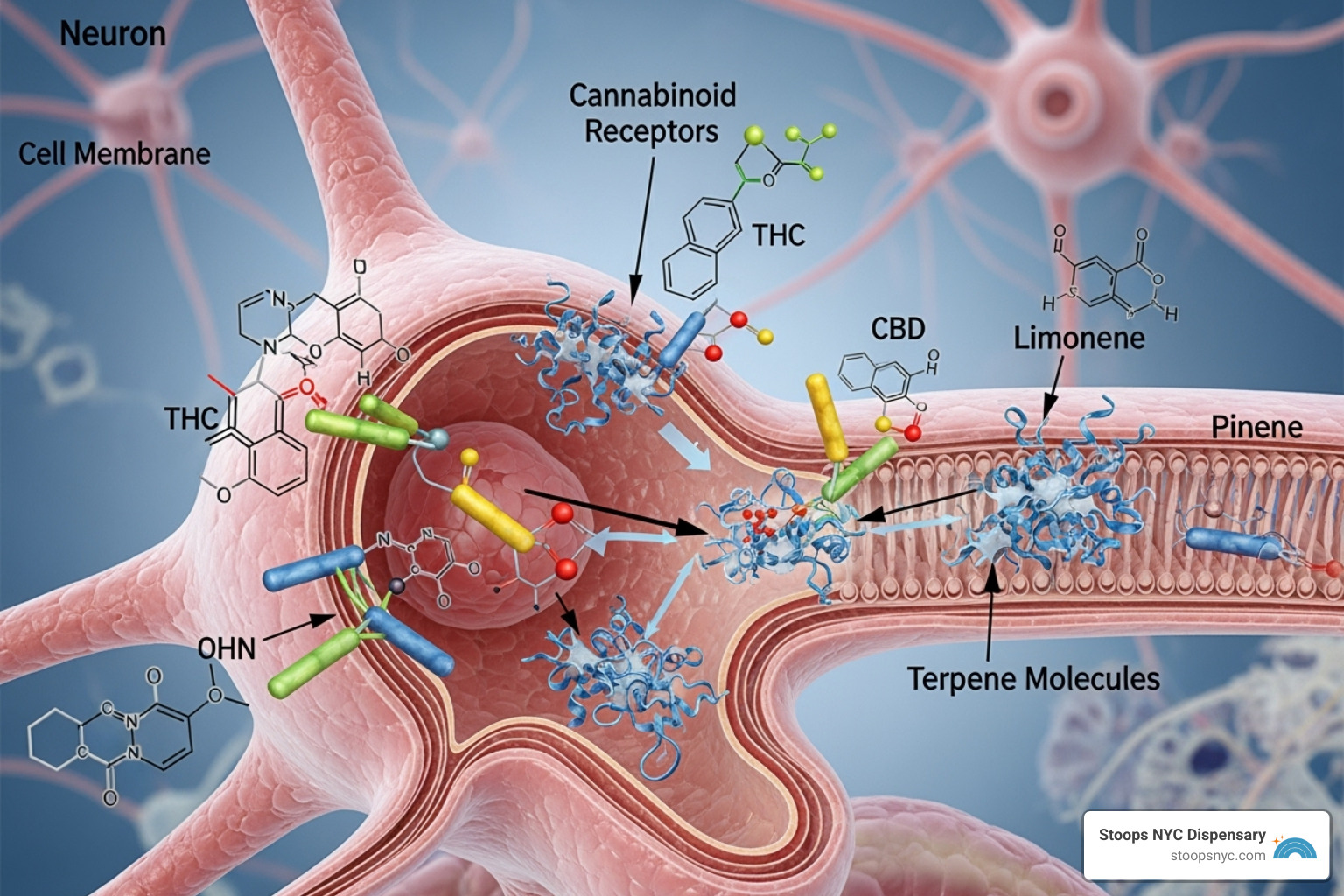Figuring out how to choose the right cannabis strain can feel overwhelming with so many option.
Here’s a quick guide:
- Know your desired effects: Do you want to relax, feel energized, or ease pain?
- Check THC and CBD levels: These key compounds change how a strain affects you.
- Look into terpenes: These compounds give strains their unique smell, taste, and effects.
- Consider your experience: If you’re new, start with lower potency.
Let’s go into detail on what truly matters when picking cannabis so you can choose with confidence.

Cannabis Categories
Most guides still divide cannabis into Indica, Sativa, and Hybrid weed.
You’ve probably heard that Indica strains are relaxing, Sativa strains are energizing, and Hybrids deliver something in between. But as modern research evolves, these old labels tell only part of the story.
From Plant Shape to Chemical Makeup
Historically, cannabis was classified by appearance:
Indicas — short, bushy plants from cooler climates.
Sativas — tall, narrow-leaf varieties from tropical regions.
Today, scientists know those physical traits say little about the actual effects.
A 2022 study of thousands of different strains of weed found “no identifiable characteristics consistent with indica, sativa, or hybrid classifications” in predicting how you’ll feel.
These plant types are useful for growers, but meaningless for you as the consumer looking for a specific effect.
So, what determines your experience with a strain of marijuana?
It’s the chemical profile. The unique blend of cannabinoids, terpenes, and flavonoids that define the strain’s personality.
Chemotypes (Type I, II, III)
Rather than relying on outdated plant categories, modern experts classify types of weed strains into chemotypes, based on their THC-to-CBD ratios:
| Chemotype | THC : CBD Ratio | General Effects |
|---|---|---|
| Type I | High THC / Low CBD | Strong psychoactive effects — best for experienced users or those seeking potent euphoria. |
| Type II | Balanced THC / CBD (1:1 or similar) | More mellow, less anxiety-inducing; ideal for beginners exploring 1:1 weed strains. |
| Type III | Low THC / High CBD (under 3 % THC) | Therapeutic, non-intoxicating effects — great for wellness users or anyone preferring low-THC high-CBD strains. |
This classification helps you understand which options are ideal for your goals — whether you want to relax, focus, or ease pain and anxiety — without being misled by old labels.
Why Terpenes Matter More Than You Think
The next layer is terpenes, the aromatic compounds that give cannabis its scent and influence effects.
Terpenes interact with cannabinoids in what scientists call the entourage effect — the synergy that shapes your mood, flavor, and body response.
Strains high in Myrcene (often found in Indicas) may promote calm and sleep.
Limonene and Pinene (common in Sativas) tend to boost energy and mood.
The ratio of terpenes to cannabinoids, sometimes referred to as terpene ratios, can influence your experience more than plant type or THC percentage alone.
So, is higher THC better? Not necessarily.
A balanced strain with a moderate THC level (say 10–15 %) and rich terpene profile may feel smoother and more enjoyable than an ultra-potent 28 % THC strain that overwhelms your system.
If you’re new or have low tolerance, start with less potent weed or balanced Type II strains.
The goal isn’t maximum THC—it’s finding your perfect strain chemistry.
Indica vs. Sativa vs. Hybrid: The Modern Perspective
| Category | Traditional Belief (Effects) | Modern Understanding (Basis for Effects) |
|---|---|---|
| Indica | Sedative, relaxing, “couch-lock” body high | Plant structure only loosely connected; calming effects more tied to Myrcene, CBD, and terpene profile. |
| Sativa | Energizing, uplifting, creative high | Historically tall plants; actual energy boost often from Limonene or Pinene, not plant height. |
| Hybrid | Mix of Indica and Sativa effects | Crossbreeds can lean either way; effects vary by THC:CBD ratio and terpene makeup, not label. |
How to Use This Information When Shopping
So, should you ignore Indica and Sativa labels?
Not completely—they can still be a rough starting point in a dispensary, as cultivators often breed strains for traditional effects. But instead of asking “Is Sativa better?” or “Which marijuana is strongest?”, look at:
THC % and CBD % (aim for a good THC percentage for your tolerance — around 10–15 % for beginners)
Terpene profile (look for strains rich in Limonene for mood or Myrcene for relaxation)
Chemotype type (Type I, II, III helps you predict intensity)
Lab reports & dispensary info (the best weed to buy is the one with clear, transparent testing)
Learning about different strains of marijuana, cannabinoid ratios, and terpene composition gives you easy-to-understand, science-based insight into what you’re smoking. This understanding helps you make personalized cannabis recommendations for yourself.
Cannabinoids and Terpenes

Here’s how to choose the right cannabis strain.
It’s easy to focus on THC alone. But the entourage effect shapes your experience, not the THC percentage.
This means that two different strains of weed with identical THC levels can feel completely different. The balance of cannabinoids, terpenes, and flavonoids—each strain’s unique chemical fingerprint—creates a distinct effect.
Understanding these building blocks is key to finding your perfect strain.
THC and CBD
Cannabinoids are the active compounds that interact with your body’s endocannabinoid system, influencing mood, energy, appetite, and pain perception.
Scientists have identified over 100 cannabinoids, but a few dominate the effects of most types of weed strains.
THC (Tetrahydrocannabinol)
THC is the primary psychoactive compound—the one responsible for the euphoric “high.”
Most Type I strains contain high THC (20 % or more).
Potent THC strains are often sought for pain relief, creativity, and relaxation, but higher doesn’t always mean better.
For first-time weed smokers, a good THC percentage ranges between 10 – 15 %, offering a pleasant high without overwhelming effects.
“Does higher THC mean stronger?” Not necessarily—the terpene ratios and supporting cannabinoids make just as much difference.
CBD (Cannabidiol)
CBD is non-intoxicatin. It’s known for calming, anti-inflammatory, and anxiety-reducing effects.
Found abundantly in Type III or high-CBD strains, it’s often below 3 % THC but above 10 % CBD.
It can balance out THC, making a strain smoother and more functional for daytime use.
CBD-dominant or 1:1 THC:CBD strains are ideal for users with low tolerance or those seeking relief without a strong high.
Minor Cannabinoids (CBG, CBN, CBC, THCV)
CBG (Cannabigerol): Believed to boost focus and support gut health.
CBN (Cannabinol): Formed as THC ages, known for sleep support and deep relaxation.
THCV (Tetrahydrocannabivarin): May provide appetite control and mental clarity.
Though small in percentage, these micro-cannabinoids help explain why some strains of marijuana feel more uplifting, soothing, or clear-headed than others.
When comparing different marijuana strains, look beyond THC %.
A balanced THC:CBD ratio (like 1:1) or low-THC high-CBD strain can offer therapeutic benefits with less intensity.
The Role of Terpenes: Aroma, Flavor, and Feel
If cannabinoids are the engine, terpenes are the steering wheel. These aromatic compounds give each strain its scent, flavor, and signature mood.
Over 200 different terpenes have been identified in cannabis varieties, influencing how the plant affects your mind and body. Understanding terpene ratios is one of the easiest ways to get easy-to-understand cannabis strain information.
| Terpene | Aroma & Flavor | Typical Effect | Common In |
|---|---|---|---|
| Myrcene | Earthy / Musky / Fruity | Deep relaxation; “couch-lock” sensation | Indica-leaning strains |
| Limonene | Citrus / Lemon Zest | Energizing, mood-boosting | Sativa strains |
| Linalool | Floral / Lavender | Calming, anti-anxiety | Hybrid and CBD strains |
| Caryophyllene | Spicy / Peppery | Anti-inflammatory; interacts with CB2 receptors | Both Indica & Hybrid |
| Pinene | Pine / Fresh Herbal | Enhances focus, counters THC-induced forgetfulness | Uplifting Sativas |
Together, cannabinoids and terpenes determine why one strain might make you giggle while another helps you unwind or sleep. This is the true entourage effect—the combination of chemistry and biology that personalizes every cannabis experience.
So, is higher terpenes better?
Often, yes—but only in balance. Strains with well-rounded terpene and cannabinoid profiles often produce fuller, more enjoyable effects than high-THC options with little aroma.
Choosing Weed by Chemistry
When deciding how to choose the right cannabis strain, think like a chemist:
Check the lab report for THC %, CBD %, and terpene ratios.
Don’t chase the highest THC strain—seek the best balance for your body.
Note which terpenes align with your goals: Limonene for creativity, Linalool for calm, Caryophyllene for physical relief.
Learning to read cannabinoid and terpene data makes strain selection more personalized and effective—and far more accurate than choosing by name alone.
How to Choose the Right Cannabis Strain
Choosing the right cannabis strain is part science, part intuition.
Every person’s body chemistry, tolerance, and intention are different, which means the best choicd for you might not be the same as what works for someone else. Your choice comes down to what you want to feel.
Here’s how to find the right strain.
Step 1: Identify Your Desired Effects
Knowing your desired outcome helps narrow down which type of weed strain to go with.
For Relaxation & Sleep Aid
Look for Indica-leaning strains rich in Myrcene, Linalool, or CBN, known for calming the body and easing tension.
A balanced THC:CBD ratio (like 1:1) or a low-THC, high-CBD strain can promote deep relaxation without overwhelming psychoactive effects.
Great for users asking, “Which marijuana strain is best for sleep?”
For Energy & Creativity
Choose Sativa strains or uplifting hybrid weed with Limonene, Pinene, or THCV for a burst of energy and focus.
These are ideal when you’re wondering “What weed strain helps with creativity or motivation?”
Moderate THC levels (15–18%) often deliver the best weed high for daytime use without anxiety.
For Pain Relief & Anti-Inflammatory Benefits
Opt for Type II strains with balanced THC and CBD content.
Caryophyllene-rich strains help relieve pain naturally.
Consider asking your budtender for medical marijuana strain recommendations for your specific condition.
For Socializing & Mood Enhancement
Seek hybrid strains with moderate THC and uplifting terpenes like Limonene or Caryophyllene.
These provide gentle euphoria, clarity, and confidence — perfect for social settings or creative gatherings.
For Focus & Clarity
Look for Pinene or THCV-dominant strains, often found in Sativas and balanced hybrids.
Avoid ultra-high THC options if you’re easily distracted or anxious — a good THC percentage for flower in this case is around 10–14%.
If you’re not sure what to request at a dispensary, tell your budtender what you want to feel (e.g., relaxed, creative, focused). Most dispensaries can give personalized strain recommendations based on your goals, tolerance, and prior experience.
Step 2: Match Your Strain to Your Experience Level
Knowing your tolerance and experience level is key to avoiding unpleasant effects and finding what works best for your body.
For Beginners
Follow the golden rule: start low, go slow.
Begin with balanced 1:1 strains or high-CBD / low-THC (Type III) options — perfect for first-time weed smokers.
Avoid high-potency strains (over 20% THC) early on. Instead, look for less potent weed that delivers smooth, manageable effects.
Dose carefully: take a single puff, or a 2.5 mg edible portion, and wait 20 minutes (inhalation) to 2 hours (edibles) before re-dosing.
What Weed Is Good for First-Time Smokers?
If you’re new to cannabis, the best weed to start with is low in THC and balanced with CBD.
These Type III or 1:1 strains create a smoother, more manageable experience that won’t overwhelm you.
What Is a Good Flower THC Percentage for Beginners?
What’s most important is the cannabinoid and terpene balance, not the THC number.
Two strains with the same THC percentage can feel totally different depending on their terpene ratios and CBD levels.
A strain with 12% THC and high Myrcene may feel stronger than a 20% THC strain high in Pinene — because terpenes shape how cannabinoids affect your body.
For Experienced Users
Once you understand your tolerance, explore high-THC (Type I) or specialty strains.
Experiment with different terpene ratios — for example, strains high in Pinene for alertness or Linalool for stress relief.
Even seasoned users should approach unfamiliar strains cautiously — mixing strains of weed can produce unexpected effects.
Step 3: Choose the Right Consumption Method
Your method of use impacts how quickly effects begin, how long they last, and how intense they feel.
Inhalation (Smoking or Vaping)
Effects are felt within minutes and last 1–3 hours.
For users who want to control their dose easily.
Vapes can deliver a cleaner experience and often feature strain-specific options.
Ask: “How do I select the best strain-specific vape for relaxation?”
Oral Consumption (Edibles or Tinctures)
Onset takes 30–120 minutes, with effects lasting up to 8 hours.
Ideal for prolonged, discreet relief.
Choose balanced THC:CBD edibles if you want therapeutic benefits without overpowering intensity.
High-THC vs. balanced THC:CBD edibles will affect strength and longevity differently.
Topicals (Creams, Balms, or Lotions)
Applied externally for localized relief from pain, soreness, or inflammation.
Non-psychoactive, making them excellent for wellness use or medical cannabis routines.
How you consume can shape your perception of the strain. The same strain can feel milder when vaped and more intense when eaten.
Always account for onset time and dose gradually.
Step 4: Choosing the Right Strain at a Dispensary
Here’s how to choose the right strain when you’re at a dispensary:
Ask for personalized cannabis strain recommendations or try an in-store strain search by effect tool.
Check the lab label for THC %, CBD %, and terpene ratios—this tells you more than the name alone.
Don’t just ask “What’s the best weed to smoke?” — instead, ask “Which strain best matches my goals?”
Try a few different marijuana strains in small amounts to learn what works best for your body chemistry.
Choose Intentionally
Instead of chasing names or hype strains, learn how to choose based on your goals, tolerance, and desired effects.
Over time, you’ll find out which cannabinoids, THC percentages, and terpene profiles create your perfect match.
When in doubt, use this simple checklist:
- Identify your goal (relax, focus, sleep, socialize).
- Choose your THC:CBD ratio and terpene profile.
- Match strain potency to your experience level.
- Ask your dispensary expert for personalized recommendations.
Frequently Asked Questions about Choosing a Strain
It’s natural to have questions. Here are answers to some common questions we get at Stoops NYC about choosing and using cannabis.
What’s the best strain for a beginner?
We recommend strains with a balanced 1:1 THC:CBD ratio or high-CBD, low-THC strains (Type III).
The CBD mellows THC’s psychoactive effects, offering a milder, more manageable experience.
This is a great way to learn how your body responds and find the right strain for you.
Can I mix different cannabis strains?
Yes. Mixing strains, or making a “salad,” allows you to customize effects by combining different cannabinoid and terpene profiles.
It’s best to first understand how each strain affects you individually before you start mixing to create a more predictable experience.
Are the effects of edibles different from smoking the same strain?
Yes, the effects are very different.
When you eat cannabis, your liver converts THC into a more potent compound. This results in a stronger, longer-lasting (4-8 hours), and more body-focused experience.
The effects also take much longer to begin (30 minutes to 2+ hours) compared to the near-instant effects of inhalation. This is a crucial difference to consider.
